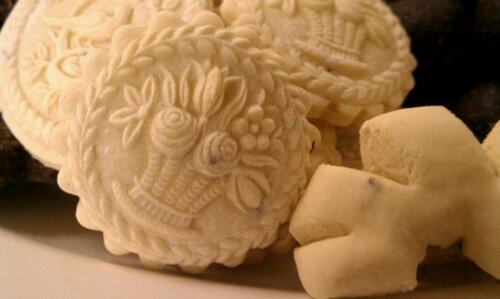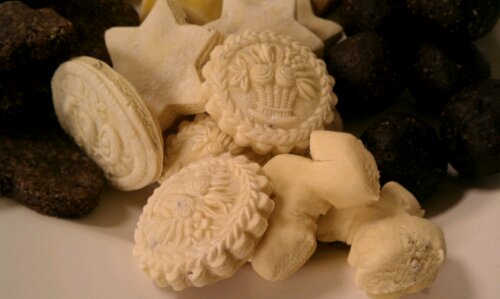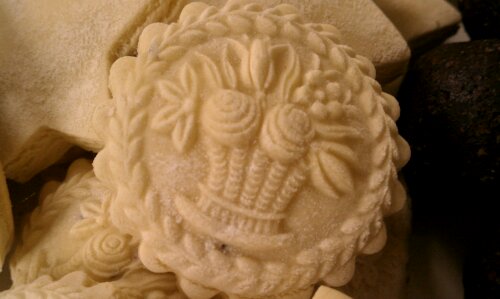Making your own Sourdough Starter

My starter when it was still a baby, just getting some little bubbles…
I have been on a mission to recreate one of my favorite breads of all times: Walliser Brot! It’s a dark dense 100% rye bread from Switzerland. Let me finish before you say, I don’t like rye bread: I don’t like any rye bread except this one myself 🙂 What is called Rye bread here is like Arizona compared to, I don’t know, Alaska, yes, that far apart. Most bread labeled rye in this part of the world contains some rye flour, lots of regular wheat flour and the part I think most people don’t appreciate: Carraway seeds. The one I long for does have none of that going on.

Well step number one in the recreation process is to get my hands on a sourdough starter, and not just any sourdough starter, but a Rye Sourdough starter.
Why not just use bakers yeast from the store? Well first, since ‘Walliser’ Bread (from the Swiss Kanton Wallis/Valais), where the river Rhône has its source technically now has an AOC (from controlled origin, kinda like Champagne can only be from the Champagne region in France hence we have Prosecco and terms like Sparkling Wine, Scotch from Scotland, etc) and the technical details advise it has to be 100% Rye, and to be made with Sourdough, and can only be called that if the Rye was grown in Valais (well, total fail on that one, for sure, but I am going to try my best to follow the rest, maybe without actually, officially calling it Walliser Brot, since as we now know, that would not be appropriate 😉
Secondly, Sourdough, is fascinating, and once you have it started much cheaper than buying yeast over and over, keeps the bread fresher and more moist for longer and due to the lactic acid that is produced during fermentation that bread won’t go stale or grow moldy nearly as quickly as yeast bread. It makes a great easy care pet, takes only about as much care as a plant once you got it well fed and going strong.
Below are some quotes I found that give a bit more detail on the health benefits of making bread with your own sourdough starter. You can make one, buy one or you can adopt one from a friend, that has one in the fridge.
“The history of bread making is a good example of the industrialization and standardization of a technique that was formerly empiric….It was simpler to replace natural leaven with brewer’s yeast. There are numerous practical advantages: the fermentation is more regular, more rapid, and the bread rises better. But the fermentation becomes mainly an alcoholic fermentation and the acidification is greatly lessened. The bread is less digestible, less tasty and spoils more easily” Claude Aubert Les Aliments Fermentes Traditionnels
“Baking with natural leaven is in harmony with nature and maintains the integrity and nutrition of the cereal grains used… The process helps to increase and reinforce our body’s absorption of the cereal’s nutrients. Unlike yeasted bread that diminished, even destroy’s much of the grain’s nutritional value, naturally leavened bread does not stale and, as it ages, maintains its original moisture much longer. A Lot of that information was known pragmatically for centuries; and thus when yeast was first introduced in France at the court of Louis XIV in March 1668, because at that time the scientists already knew that the use of yeast would imperil the people’s health, it was strongly rejected. Today, yeast is used almost universally, without any testing; and the recent scientific evidence and clinical findings are confirming that ancient taboos with biochemical and bioelectronic valid proofs that wholly support that age-old common sense decision”. Jacques DeLangre
Essentially you are propagating a living organism, bacteria and wild yeast that feed on the sugars found in the flour, giving off gas as they do so, hence the bubbles that leaven the bread. Since it is alive, you have to feed your new pet(s), but the nice thing is, they do everything slower at lower temperatures. So once established, you can keep it in the fridge and take it out to feed once every couple of days, once a week at the minimum.
The King Arthur Flour Website has some great info on how to revive a neglected starter, de-sour one that has gotten too sour (discard most and feed 2 cups flour, 1 1/2 cups water) and I think they also sell one (not rye though)
There are many recipe’s for this out there, and some make it sound like it is super complicated, also a lot of instructions have you discard half of the starter at every ‘feeding’ which I think is just wasteful. I had a wheat sourdough that I ‘made’ at some point and I remember it took a while to get it going, but the one I made with rye, was up and ready in no time. Apparently rye ferments more readily. But there is luck involved and it might not always work, depending on the organism that lie dormant on the grain or happen to float through the air at the time. Time of year, temperature, all those variables come into play.
So let’s get started:
You will need: Whole grain, unbromated, unbleached Rye flour (you could use pumpernickel flour for some of the feedings), Water, Glass container to keep the starter, something to stir, tape and pen to mark the level so you can check how much it came up
Day 1:
- 1/2 cup whole grain rye flour (or if you have a grain mill, grind some fresh)
- 1/2 cup warm filtered water (try to avoid chlorine if you can)
- Stir the flour and water together in a the glass container, cover loosely with a lid or plastic wrap and set aside (room temp!)
Day 2:
- add 1/4 cup Rye flour, 1/4 cup luke warm water, place the tape on the outside of the glass, make a line where the ‘dough’ ends so you can check if anything is happening yet (on mine it did start to make bubbles)
Day 3 & after:
- add another 1/4 cup rye flour, and 1/4 cup water, if nothing much happened (If it got very bubbly and then fell again, add 1/2 cup flour/1/4 cup water, your pet is hungry!) Remove the tape and re-position so the line marks the dough level again.
Your goal is to get the starter to double in size, with my starter, that now takes about 6 hours. So keep feeding once a day until the starter gets really bubbly. If you run out of space, remove half of the starter, discard and then feed flour to the rest. And if after 6 days still nothing happened, you might have to call it quits and try again at a later time, or ask around, someone might have one, they most likely will be able to give you a piece you can feed into your own starter.
 Active and bubbly!
Active and bubbly!
From the King Arthur Website: on Storing your sourdough starter:
Storing
Refrigerating – Once your sourdough starter is safely in the refrigerator, it will need a little attention, although once it’s cold and relatively dormant, it can survive quite a long time between “feedings.” It is certainly not as demanding as children or more traditional pets, but it won’t just sit for months on end like a packet of commercially dried yeast either.
Freezing – You may be able to ignore your starter for a month or even much longer, but if you know you’re going to be away for a time, you can store it, unlike children or pets, in the freezer. You may want to transfer it to a plastic container first since it will expand as it freezes.
When you are ready to use it again, give it a day to revive, feed it a good meal, give it another day to build up an armada of fresh, new wild siblings and it will be ready to go to work.
Drying – An alternative storage method is to dry your starter by spreading it out on a piece of heavy plastic wrap or waxed paper. Once it’s dry, crumble it up and put it in an airtight container. Store it someplace cool or, to be safe, in the freezer.
To reactivate the culture, place the dried starter in a mixture of flour and water as described in the first section. To help the dried chunks dissolve, you can grind them into smaller particles with a hand cranked grinder, a blender or a food processor before you add them to the flour/water mixture.
 Walliser Roggenbrot (in French: Pain au Seigle) with the traditional cracks on the surface. Let’s see how well I will do…
Walliser Roggenbrot (in French: Pain au Seigle) with the traditional cracks on the surface. Let’s see how well I will do…
Copyright © 2012 Simple Healthy Homemade. All rights reserved

 What it looked like coming out of the oven…
What it looked like coming out of the oven…





 ← Just to give you an idea, the Mango varieties out there are in the hundreds, if not thousands. Over 500 varieties are known in India, the largest producer of mango in the world.
← Just to give you an idea, the Mango varieties out there are in the hundreds, if not thousands. Over 500 varieties are known in India, the largest producer of mango in the world.
 Make sure you pack the crumb crust down firmly. Push progressively more as the crust starts to hold together
Make sure you pack the crumb crust down firmly. Push progressively more as the crust starts to hold together

 Active and bubbly!
Active and bubbly! Walliser Roggenbrot (in French: Pain au Seigle) with the traditional cracks on the surface. Let’s see how well I will do…
Walliser Roggenbrot (in French: Pain au Seigle) with the traditional cracks on the surface. Let’s see how well I will do…
 Because heart-shaped things make me happy 🙂
Because heart-shaped things make me happy 🙂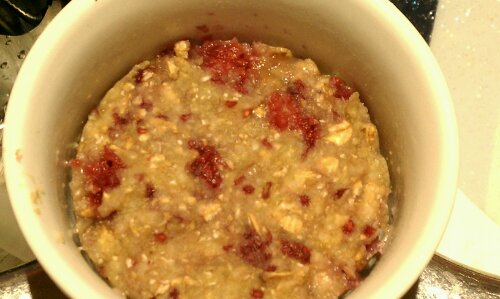


 Dough rolled out ‘rectangular’, with filling. And roll it up…
Dough rolled out ‘rectangular’, with filling. And roll it up… cut with a sharp knife…
cut with a sharp knife… ... twist and set into your prepared cake pan
... twist and set into your prepared cake pan Apples and Nuts and just a little sugar turn this bread into a
Apples and Nuts and just a little sugar turn this bread into a 
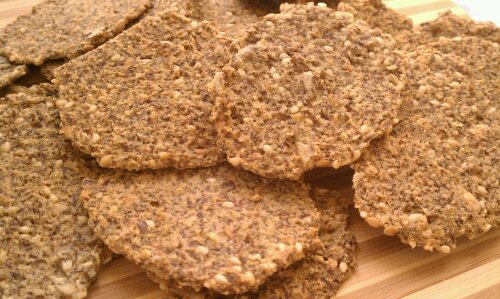
 batch one & two
batch one & two the only downside? You could always eat more than there are left…
the only downside? You could always eat more than there are left…

 as you can see, the dough is very soft and cutting it into squares, was a bit of a challenge
as you can see, the dough is very soft and cutting it into squares, was a bit of a challenge after that the pieces got to rest and rise, here ready for frying (Note: the recipe suggest to put them on wax paper, which I did. The result? The whole thing sticks, I
after that the pieces got to rest and rise, here ready for frying (Note: the recipe suggest to put them on wax paper, which I did. The result? The whole thing sticks, I  some leftover dough pieces getting fried…
some leftover dough pieces getting fried… the finished product, here I tossed some in sugar, left some plain. They are also delicious with cinnamon and sugar, but I hear traditionally, some folks cut them in half and butter or syrup them up. Yes, you heard right, syrup 🙂 I don’t think I’d survive that much sugar, but by all means, go try it.
the finished product, here I tossed some in sugar, left some plain. They are also delicious with cinnamon and sugar, but I hear traditionally, some folks cut them in half and butter or syrup them up. Yes, you heard right, syrup 🙂 I don’t think I’d survive that much sugar, but by all means, go try it.
 they end up pretty airy, I think the recipe could easily get away with less yeast. But they are delicious! Now off to the office to have them authenticated by the experts 😉
they end up pretty airy, I think the recipe could easily get away with less yeast. But they are delicious! Now off to the office to have them authenticated by the experts 😉 Ingredients
Ingredients



